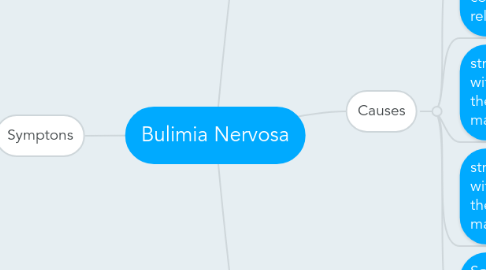
1. Symptons
1.1. Psychological Signs
1.1.1. Preoccupation with eating, food, body shape and weight
1.1.2. Sensitivity to comments relating to food, weight, body shape or exercise
1.1.3. Low self esteem and feelings of shame, self loathing or guilt, particularly after eating
1.1.4. Having a distorted body image (e.g. seeing themselves as fat even if they are in a healthy weight range for their age and height)
1.1.5. Obsession with food and need for control
1.1.6. Depression, anxiety or irritability
1.1.7. Extreme body dissatisfaction
1.2. Physical signs
1.2.1. Frequent changes in weight (loss or gains)
1.2.2. Signs of damage due to vomiting including swelling around the cheeks or jaw, calluses on knuckles, damage to teeth and bad breath
1.2.3. Feeling bloated, constipated or developing intolerances to food
1.2.4. Loss of or disturbance of menstrual periods in girls and women
1.2.5. Fainting or dizziness
1.2.6. Feeling tired and not sleeping wel
1.3. Behavioural Signs
1.3.1. Evidence of binge eating (e.g. disappearance of food)
1.3.2. Vomiting or using laxatives
1.3.3. Eating in private and avoiding meals with other people
1.3.4. Anti social behaviour, spending more and more time alone
1.3.5. Repetitive or obsessive behaviours relating to body shape and weight (e.g. weighing themselves repeatedly, looking in the mirror obsessively and pinching waist or wrists)
1.3.6. Secretive behaviour around food (e.g. saying they have eaten when they haven’t, hiding uneaten food in their rooms)
1.3.7. Compulsive or excessive exercising (e.g. including exercising in bad weather, in spite of sickness, injury or social events and experiencing distress if exercise is not possible)
1.3.8. Dieting behaviour
1.3.9. Frequent trips to the bathroom during or shortly after meals which could be evidence of vomiting or laxative use
1.3.10. elf harm, substance abuse or suicide attempts
2. What is it?
2.1. What is binge eating?
2.1.1. Binge eating involves two key features: • Eating a very large amount of food within a relatively short period of time (e.g. within two hours) • Feeling a sense of
2.2. Bulimia Nervosa is a serious mental illness that requires treatment; it is not a lifestyle choice. Bulimia Nervosa is characterised by repeated episodes of binge eating followed by compensatory behaviours.
2.3. What are compensatory behaviours?
2.3.1. They include: • Vomiting • Misusing laxatives or diuretics • Fasting • Excessive exercise • Use of any drugs, illicit, prescription and/or ‘over the counter’ inappropriately for weight control (inappropriate use refers to use that is not indicated and for which the drug has not been prescribed).
2.3.2. A person with Bulimia Nervosa can lose control and attempt to compensate which can lead to feelings of shame, guilt and disgust.
2.3.3. These behaviours are often concealed and people with Bulimia Nervosa can go to great lengths to keep their eating and exercise habits secret. As a result, Bulimia Nervosa can often go undetected for a long period of time
3. Causes
3.1. Self harm, substance abuse or suicide attempts
3.2. depression – you may use binging as a way of coping with unhappiness, but purging does not relieve this depression and the cycle continues
3.3. stress – for example, you may develop the condition after dealing with a traumatic experience, such as a death or divorce, or during the course of important life-changing events, such as getting married or leaving home
3.4. stress – for example, you may develop the condition after dealing with a traumatic experience, such as a death or divorce, or during the course of important life-changing events, such as getting married or leaving home
3.5. Some people with bulimia have experienced a difficult childhood, with family problems, arguments and criticism.
4. Treatment
4.1. Cognitive behavioural therapy (CBT) is the most common type of psychological treatment for bulimia. It involves talking to a therapist and looking at your emotions in detail to work out new ways of thinking about situations, feelings and food. It may also involve keeping a food diary, which will help determine what triggers your binge eating.
4.2. Interpersonal therapy As with CBT, interpersonal therapy (IPT) involves meeting with a therapist to discuss your condition. However, the focus is more on your personal relationships than your problems with food
4.3. Medication
4.3.1. Antidepressants
4.3.2. fluoxetine
4.4. Hospital treatment
4.4.1. Bulimia is not usually treated in hospital. However, if you have serious health complications and your life is at risk, you may be admitted to hospital. Hospital treatment is also considered if you are at risk of suicide or self-harm.
4.5. The recovery process Once diagnosed, people with bulimia can recover, but it may take a long time. The longer someone has had bulimia, the harder it is to re-learn healthy eating habits and gain weight
4.5.1. change their eating habits
4.5.2. change the way they think about food
4.5.3. gain weight safely, if necessary

